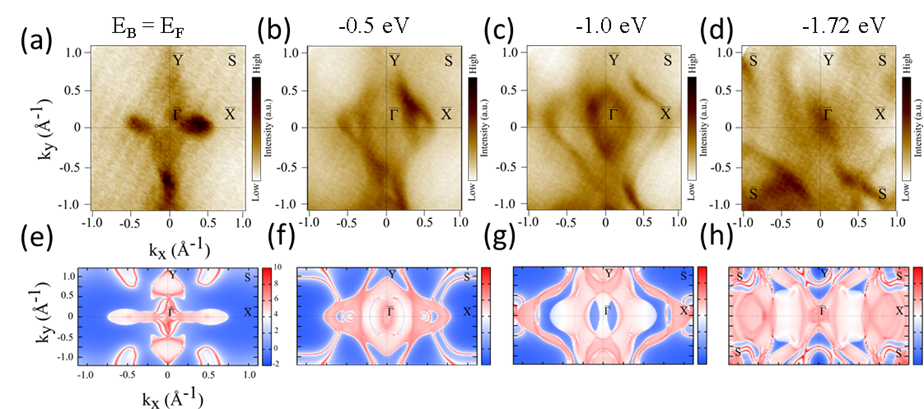To view the recording of the talk, please contact Prof. Andrzej Szewczyk:
Materials with topologically non-trivial electronic states and diverse symmetry properties have gained significant attention in condensed matter physics. Among these, ZrAs2 stands out as a notable example, exhibiting nodal lines that form closed loops in momentum space, governed by several symmetries such as inversion symmetry, time reversal symmetry and non-symmorphic symmetries [1-3]. This study explores the electronic properties of ZrAs2 using a combination of angle-resolved photoemission spectroscopy (ARPES) and density functional theory (DFT) calculations (see Figure 1).
ARPES measurements revealed a well-defined nodal loop structure, particularly prominent at lower excitation energies of 30 and 50 eV. These findings, corroborated by DFT calculations, highlighted symmetry-enforced Dirac-like band crossings at specific points within the Brillouin zone, notably near the S point. Slab calculations further delineate the surface bands and bulk states associated with these crossings, aligning well with experimental data [4].

Figure 1 Comparison between constant energy contours obtained by ARPES and DFT calculations at binding energy equal to: (a, e) EF, (b, f) -0.5 eV, (c, g) -1.0 eV and (d, h) -1.72 eV.
[1] P. E. R. Blanchard, R. G. Cavell, and A. Mar, J. Alloys Compd. 505, 17 (2010).
[2] X. Zhou, C. H. Hsu, H. Aramberri, M. Iraola, C. Y. Huang, J. L. Mañes, M. G. Vergniory, H. Lin, and N. Kioussis, Phys. Rev. B 104, 125135 (2021).
[3] S. Nandi, B. B. Maity, V. Sharma, R. Verma, V. Saini, B. Singh, D. Aoki, and A. Thamizhavel, Phys. Rev. B 109, 075155 (2024).
[4] A. S. Wadge, K. Zberecki, B. J. Kowalski, D. Jastrzębski, P. K. Tanwar, P. Iwanowski, R. Diduszko, A. Moosarikandy, M. Rosmus, N. Olszowska, A. Wiśniewski, Phys. Rev. B 110, 035142 (2024).
The seminar will be given in English on-site in room 203. ZOOM transmission will be available too.
List of Dates (Page event details)
- 27-11-2024 10:00 - 11:00




